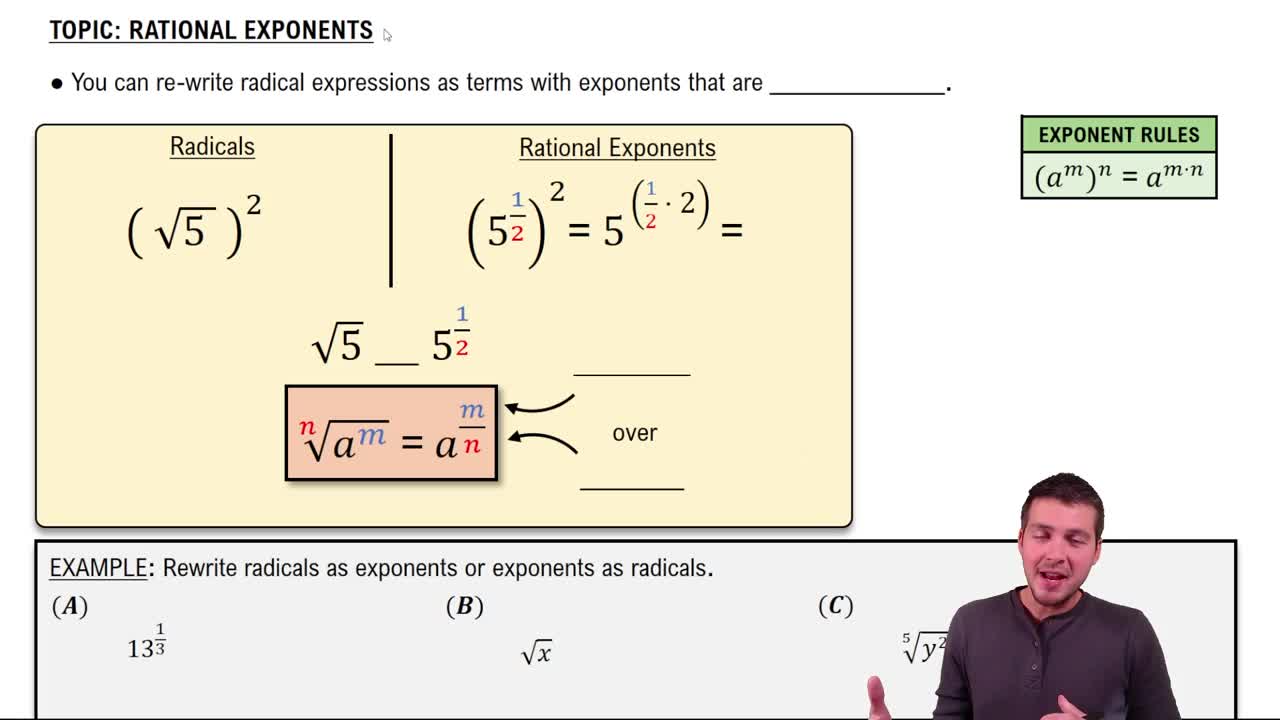Table of contents
- 0. Review of Algebra4h 16m
- 1. Equations & Inequalities3h 18m
- 2. Graphs of Equations43m
- 3. Functions2h 17m
- 4. Polynomial Functions1h 44m
- 5. Rational Functions1h 23m
- 6. Exponential & Logarithmic Functions2h 28m
- 7. Systems of Equations & Matrices4h 6m
- 8. Conic Sections2h 23m
- 9. Sequences, Series, & Induction1h 19m
- 10. Combinatorics & Probability1h 45m
0. Review of Algebra
Rational Exponents
Problem 106
Textbook Question
Solve each equation for the specified variable. (Assume all denominators are nonzero.) x^2/3+y^2/3=a^2/3, for y
 Verified step by step guidance
Verified step by step guidance1
Start with the given equation: \( \frac{x^{2/3}}{1} + \frac{y^{2/3}}{1} = \frac{a^{2/3}}{1} \).
Subtract \( \frac{x^{2/3}}{1} \) from both sides to isolate the term with \( y \): \( \frac{y^{2/3}}{1} = \frac{a^{2/3}}{1} - \frac{x^{2/3}}{1} \).
To solve for \( y \), raise both sides of the equation to the power of \( \frac{3}{2} \) to eliminate the fractional exponent: \( y = \left( \frac{a^{2/3} - x^{2/3}}{1} \right)^{3/2} \).
Simplify the expression if possible, ensuring that all terms are correctly combined under the power.
Verify the solution by substituting back into the original equation to ensure it holds true.
Recommended similar problem, with video answer:
 Verified Solution
Verified SolutionThis video solution was recommended by our tutors as helpful for the problem above
Video duration:
2mPlay a video:
Was this helpful?
Key Concepts
Here are the essential concepts you must grasp in order to answer the question correctly.
Solving for a Variable
Solving for a variable involves isolating that variable on one side of the equation. This process often requires algebraic manipulation, such as adding, subtracting, multiplying, or dividing both sides of the equation by the same value. In this case, we need to rearrange the equation to express y in terms of x and a.
Recommended video:
Guided course

Equations with Two Variables
Exponents and Fractional Powers
Exponents represent repeated multiplication, and fractional powers indicate roots. For example, x^(2/3) means the cube root of x squared. Understanding how to manipulate these powers is crucial for solving equations involving them, as it allows us to rewrite terms in a more manageable form.
Recommended video:

Powers of i
Implicit Functions
An implicit function is defined by an equation that relates multiple variables without explicitly solving for one variable. In this case, the equation x^(2/3) + y^(2/3) = a^(2/3) defines y implicitly. Recognizing how to extract y from such equations is essential for finding its explicit form.
Recommended video:

Function Composition

 4:06m
4:06mWatch next
Master Rational Exponents with a bite sized video explanation from Patrick Ford
Start learningRelated Videos
Related Practice


